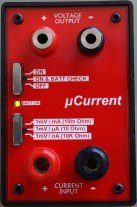µCurrent™
A Professional Precision Current Adapter for Multimeters

Here is something you probably didn’t know:
NO digital multimeter is accurate at measuring DC or AC current in low voltage circuits.
The closer to full scale you get and the lower your circuit supply voltage gets, the more inaccurate your current measurement gets.
YES, that includes your expensive “precision” 0.05% Fluke!
How is this possible? – It’s called Burden Voltage.
Many people are aware of Burden Voltage, but few people are aware of how bad this effect can be in practical circuit current measurements with a multimeter.
Don’t believe it?, take this simple test with your multimeter:
-
Try to measure 190mA on the 200mA current range (pretty simple huh?)
-
Read your manual to find out your meters “burden voltage” (I bet you don’t know it off the top of your head) (e.g. a Fluke 87V is 1.8mV/mA)
-
Do the simple math to see what voltage your meter is dropping (e.g. 190(mA) * 1.8mV = 0.342V
-
Now calculate what effect this drop has on your circuit at 5V, 3.3V, or something like today’s modern devices that need 1.2V supplies.
Is your 1.2V circuit going to work at 0.86V?, or your 3.3V circuit at 2.96V?, or even your 5V circuit at 4.66V?
That’s what a Fluke 87V meter will do to your measurement!, and that’s a GOOD meter.
Even if your circuit “works”, what will that change in voltage do to your current consumption?
Try the same again with a Fluke 77-III or 79-III, you will be SHOCKED at the result!
“Ah, but I can just switch to the 2A or 10A range and the problem is GONE!”
Sorry! – you’ve just LOST one or two digits of resolution!, AND your meters 10A range is much less accurate than the 200mA range.
Does that come as a surprise? That’s ok, you aren’t alone, most people are not fully aware of this severe limitation of their multimeter.
The uCurrent™ is the only commercially available solution to this problem:
As published in the April 2009 issue of Silicon Chip Magazine.
|
Specifications
|
PLEASE NOTE: Due to need to keep the burden voltage low, overload protection is NOT INCLUDED in the design. That means NO FUSES. Care is required in using the unit to prevent overloads.


Read the FULL ARTICLE (Description, Design, How it Works, Parts List, Testing etc, as published in Silicon Chip magazine)
View the SCHEMATIC
View the bottom side PCB assembly
View the bottom side Component Overlay (the one in the SC article is hard to read!)
Download the original Altium PCB and Schematic files HERE.
BUY ONE in the EEVblog Shop
(Australian Customers ONLY)
US/Canadian customers – Available through Adafruit
EU Customers – Available through Robot-Italy
Asia/Pacific Customers – Available through SGBotic
 EEVblog No Script, No Fear, All Opinion
EEVblog No Script, No Fear, All Opinion



